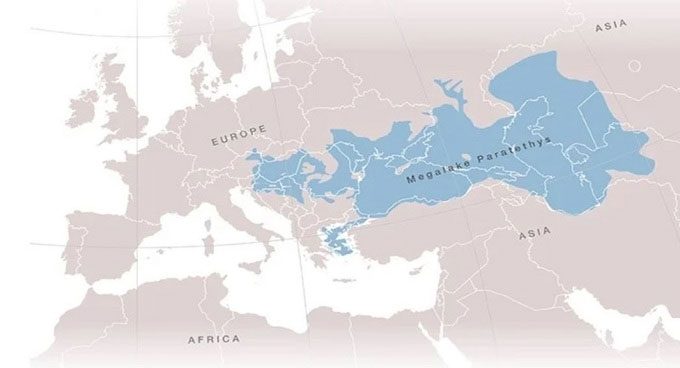About 10 million years ago, the Paratethys Sea, the largest lake in Earth’s history, covered a larger area than the Mediterranean Sea today.
On modern maps, the Paratethys Sea stretched from the Alps above Italy to Kazakhstan in Central Asia. To date, researchers know very little about the tidal fluctuations of the Paratethys Sea during its existence, but a new study published on June 1 in the journal Scientific Reports identifies four cycles that caused the lake to shrink under the influence of climate fluctuations, likely leading to the death of a large number of organisms within the lake.

The Paratethys Sea on the map. (Photo: Utrecht University).
Aquatic life in the Paratethys Sea was unique, including species ranging from clams and crustaceans to whales and small dolphins that evolved to adapt to the restricted environment. However, as water levels decreased and salinity increased, very few species could survive, according to geologist Wout Krijgsman from Utrecht University in the Netherlands.
Krijgsman and his research team studied fossils, sediments, and the geology of the area around the Black Sea (which was once the center of the Paratethys Sea) to identify four significant drops in water levels over several million years, while also modeling and simulating water levels in the region.
The most severe drop occurred last, around 7.65 to 7.9 million years ago, known as the Great Khersonian Drying. During this period, the water level in the Paratethys Sea decreased by 250 meters, separating this superlake into smaller lakes that were sometimes too toxic for most aquatic animals. According to the research team’s calculations, the superlake could lose up to 70% of its surface area and one-third of its volume during the drought period.
At its peak capacity, the Paratethys Sea covered an area of 2.8 million km2, containing a volume of water ten times greater than all the lakes on Earth combined today. Changes in temperature and precipitation across the Eurasian continent also affected the land, with open areas replacing forested land and types of woodlands changing. Researchers still do not fully understand how these processes interact with one another.
Formed from tectonic plate movements and the uplift of mountain ranges in Central Europe, geological records indicate that the Paratethys Sea existed for about 5 million years before landscape changes caused its waters to flow into the Mediterranean Sea. Another recent study indicated that the decreasing water levels around the Paratethys Sea transformed the coastal areas into grasslands, providing fertile land for herbivores.





















































